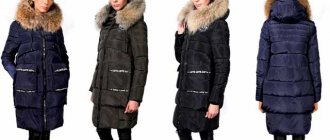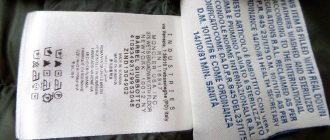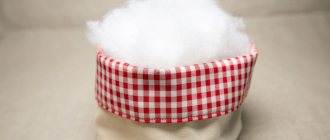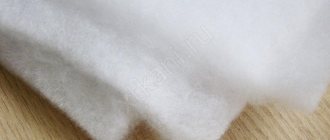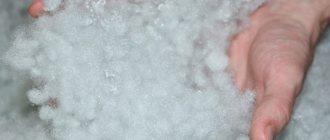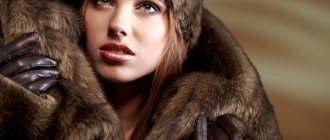Types of filling for winter jackets
All down jacket fillers can be divided into two groups:
- natural;
- synthetic.
The first type naturally includes goose down and feathers. The second group includes synthetic winterizer. These have long been known insulation materials. But science and progress do not stand still, and now there are many modern insulation materials on the market.
Thinsulate filler: what is it, pros and cons, what temperature is it designed for?
Thinsulate can rightfully be considered a new generation of insulation. The name is not simple, but in other words it is artificial swan's down. This insulation is a siliconized polyester fiber twisted into a spiral. This fiber is 60 times thinner than human hair, its diameter is 5 microns. The fiber spirals are covered with silicone around which there is air, it is this air that retains heat and warms. Thinsulate was invented back in the 60s of the last century by order of NASA. it was intended to insulate the spacesuits of astronauts and polar explorers. Now this material is used in sewing equipment for skiers. In terms of thermal characteristics, Thinsulate is 1.5 times higher than natural swan down.
Like all materials, it has its advantages:
- holds heat well;
- light and soft;
- does not fall off when worn;
- not allergic;
- environmentally friendly material;
- does not absorb odors; lasting;
- does not deform after washing and does not shrink;
- dries quickly.
There are also disadvantages and they are worth talking about:
- accumulates static electricity;
- may cause overheating.
Considering all of the above, jackets with thinsulate are suitable for regions with harsh winters and those who enjoy skiing or snowboarding. It is in such conditions that it will warm the body and provide comfort.
Types of materials and their main characteristics
Polyester is the name of the substance from which different types of fillers are made. Due to differences in manufacturing, they have different characteristics and are designed for different weather conditions.
100% polyester insulation
Polyester filler was popular in the USSR, but today it is used much less frequently. This is due to its shortcomings: it caked, lost its shape, and could not be washed often. Today, other materials are used for outerwear and blankets: isosoft, holofiber, etc.
You may be interested in 100% polyester fabric: synthetic material or not
Holofiber
Hollofiber is a non-woven synthetic material made from hollow polyester fibers twisted in a spiral. Its feature is the soldering of fibers using high temperatures (in the rest they stick together). The material has a high level of heat and sound insulation, allows air to pass through well, but retains moisture, is resistant to washing and physical impact, holds its shape well and restores it. The material is also hypoallergenic, it does not harbor insects and does not accumulate dust.
Holofiber insulation
Thinsulate as an innovative insulation
The second name is artificial swan down. Initially it was used as insulation for space assemblies; today it is also used in the manufacture of outerwear. Can be worn at temperatures down to -40 °C, does not absorb odors and water, and does not interfere with air circulation. Also, the material is quite thin and light, easy to wash and clean, and does not wear out over time.
Thinsulate insulation
Isosoft
This is a modern insulation, the fibers of which are coated with special polymers to enhance heat-insulating properties. They are highly twisted and the fibers are often spherical in shape. The filler is used in pillows, blankets, sleeping bags, and winter outerwear. Depending on the density, the material can withstand from -10 °C to -30 °C. Isosoft allows air to pass through well, while retaining heat, is not subject to deformation and does not require special care.
Isosoft insulation
Sintepon
Sintepon is a synthetic insulation whose fibers are glued together using needles, glue or high temperatures. It was received in the mid-30s. XX century in England, it came to the USSR only in 1949. The material is quite light and comfortable to wear, does not deform (subject to temperature conditions), does not get wet and has a high level of thermal insulation.
Insulation synthetic winterizer
Sintepooh
It has all the advantages of natural fluff, but is obtained artificially. In its production, silicone treatment is used, which prevents the product from bunching up. Synthetic down can withstand down to -30°C, does not pill when washed, quickly takes its original shape and dries. When worn, the effect of a “steam room” is not created, since the air passes well through the synthetic fluff, but the heat does not escape.
Synthetic insulation
Holofiber filler, what is it, pros and cons, what temperature is it designed for?
What is it. The answer is simple, like everything ingenious. The translation of this word from English means “hollow fibers.” Hollofiber is made of synthetic fiber that is hollow inside and twisted. It is this structure that allows for good heat retention.
The positive qualities of this material include:
- ease;
- high thermal conductivity;
- affordable price; does not electrolyze;
- does not absorb foreign odors;
- hypoallergenic.
Holofiber has no negative qualities. It is worth noting that the thermal properties are slightly inferior to goose down and feathers. As for the temperature regime, first of all we need to talk about the density of the insulation (the higher the density, the stronger the frost it can withstand). For winter, it is best to choose jackets with a holofiber density of 200 g/sq.m, temperature -10 -20 degrees, and 300 g/sq.m, temperature -20 -30 degrees.
What is holophane insulation and how is it produced?
Hollophan is a synthetic material made from molten polyester, or lavsan. Its fibers have a spiral shape, so the fabric is very elastic and breathable, and retains heat well.
There are several categories of insulation, differing in density:
- 100–150 gsm m – suitable for autumn and winter at temperatures 4–10°C above zero;
- 150–200 gsm m - winter jackets are filled with such insulation, which can be worn in cold weather down to -10°C);
- 250 g/sq. m – suitable for wear in winter at temperatures from -10 to -25°C;
- 300–400 gsm m – retains heat in frosts down to -35°C.
To sew children's outerwear, the factory uses siliconized holophane. This thermal insulation is even more flexible and durable, which increases its wear resistance. Sometimes the material is mixed with natural fiber - sheep's wool, which has a structure similar to holophane. To reduce the likelihood of fiber migration, the fabric is exposed to high temperatures.
Sustans filler what is it, pros and cons what temperature is it designed for
Sustans insulation is a type of bio-down. It is produced using a biopolymer, which is patented by DuPont Sorona. It was this filler that received approval for the “bio-based product” label in America. The spherical shape of the fibers makes the filler fluffy and silky to the touch. It retains heat well and is ideal for winter clothing. A jacket with sustans will keep you warm even at 40 degrees.
What is Thinsulate: reviews about insulation
Thinsulate is a synthetic non-woven material consisting of the finest fibers interconnected. It is obtained from petroleum products. As a result of a complex chemical reaction, insulation is obtained, which compares favorably with existing analogues.
Thinsulate production
The production of Thinsulate was established about 30 years ago, using equipment for producing adhesive tape as a basis. It was heated and then spun, resulting in a synthetic polyester substance with thin fibers that have the structure of a spring. This insulation is considered an artificial down substitute. It is used in down jackets everywhere. The advantage of this insulation is its small thickness compared to other synthetic fillers.
Winter Thinsulate
Winter Thinsulate is a filler for modern winter clothing. It is used to fill the suits of polar explorers who live and work in permafrost conditions for a long time. Depending on the thickness of the fibers of a given material, it is determined at what temperature the Thinsulate is designed. In modern clothes, a certain type of this filler is used. It creates an air layer that prevents the penetration of cold. It has a low specific gravity and is a hypoallergenic material. Thinsulate does not break down and does not shrink. Wears well and is easy to wash. To ensure that this insulation retains heat well in winter, it is used only with high-quality materials.
Female Thinsulate
Women's Thinsulate is a 2-3 millimeter thick insulation that is used in women's dress and sportswear. This insulation has elasticity and a very small thickness; these characteristics are in demand when sewing winter, demi-season and sports women's clothing. What woman would refuse a light, warm jacket that retains heat well and is made from quality materials? The advantage of this insulation is its long service life. It wears well, while maintaining its original properties for a long time. For women's clothing, this is a big plus, since outerwear is bought for more than one season. Thinsulate can be washed either by hand or in a washing machine. When washing in a machine, select a delicate washing mode, where the spin speed does not exceed 600, and the heating water temperature for washing is 40°C. Often, products where Thinsulate is used can be washed at home many times. But if this is not permissible, then such products are sent to dry cleaning. This insulation tolerates this method of cleaning the product well. Buyers speak of Thinsulain as a filler that retains heat well if the product is made of windproof material. And if you use drape, tweed or a knitted base, which easily allows wind, cold and moisture to pass through, then cold air gets into the insulation. There are a lot of opinions about what is better than Thinsulate: some praise Isosoft, some praise synthetic winterizer, and some like holofiber.
Isosoft filler, what is it, pros and cons, what temperature is it designed for?
Isosoft is an innovative material that was invented by Libeltex specialists, who initially made highly sensitive filters. The insulation is made from hollow fibers of a polyester polymer called fine-denie.
Isosoft has a number of positive qualities:
- hypoallergenic;
- great thermal insulation;
- excellent breathability;
- dries quickly;
- Machine washable.
The insulation is weightless, which is good for winter jackets. It will be easy and comfortable to walk in it. Thanks to the properties of the material, the jackets are very warm. Clothing with isosoft is very warm and can withstand frost down to -35 degrees. Strong wind is also not a problem, because... the material is not blown through. This insulation is often used for sewing winter clothes for children. Isosoft is not cheap, but its qualities will pleasantly surprise the owner and warm him up in the winter cold.
How to choose winter clothes with synthetic filling
When choosing winter clothes, you should pay attention to some nuances:
- the filler should hold its shape well. To check, you should strongly squeeze the sleeve or other place and see how quickly the jacket “recovers”;
- the more machine stitches there are on the polyester (lining), the more cold air it lets through;
- Clothing should fit snugly to the body near the throat, at the cuffs and at the bottom. For better thermal insulation, there may be a double layer of insulation on the back and hem;
- it is important to pay attention to the fabric itself and the lining;
- the inside of the down jacket should be divided into small cells filled with insulation. This way the inner material is evenly distributed throughout the clothing and does not roll or crumple.
You might be interested in this Description and features of universal microfiber cloths
Cell division example
Important! When choosing clothes with natural insulation, the rules will be different.
Baby go filler what is it, pros and cons what temperature is it designed for
Baby Go is a Russian brand of clothing for children, aimed at the domestic market. Particular attention is paid to outerwear. After all, with the arrival of cold weather, parents want to buy a warm and practical thing. Clothes are made from high-quality material. The top of the jackets is predominantly made of polyester, the lining is a mixture of polyester and cotton. The filling is most often natural down and feathers.
Such outerwear will have the following advantages:
- not allergenic;
- environmentally friendly filler;
- warm;
- easy fabric care.
You will be comfortable in such a jacket even at -30 degrees. Wind and precipitation are also not a problem.
Where is it used?
Polyester filler is used in many areas:
- insulation of houses;
- car seat filling;
- insulation of sports items, outerwear;
- making quilted lining;
- the inside of pillows, blankets;
- filling soft toys, sides of cribs;
- production of thermal underwear, sleeping bags;
- making the insides of autumn and winter boots.
Various materials are made from polyester fibers. They are becoming more and more popular.
Lining fabric
Polyester lining material is used for the following products:
- trousers, dresses, skirts, suits;
- jackets, jackets, coats;
- winter jackets and overalls.
The polyester lining does not wrinkle or stretch, and remains in its original form for a long time. It does not allow moisture and heat to pass through. Winter polyester lining fabrics are supplemented with thermal protection.
Read about: fibertek insulation
Camel wool filler reviews, pros and cons, what temperature it is designed for
Camel wool has long been valued for its high thermal properties. It is very warm and light. If you compare the wool of merino sheep and camels, the wool of the latter is twice as light.
This filler has the following advantages:
- in terms of thermal conductivity properties, camel wool is superior to other types of wool;
- the effect of dry heat has a beneficial effect on the human body and can relieve symptoms of colds, neuritis, and osteochondrosis;
- wool fibers have micropores, which allows it to breathe, which means it retains heat better; does not electrolyze;
- does not get dirty when worn;
- repels dust.
A jacket with camel hair will be comfortable even at 20 or 30 degrees below zero. You need to take proper care of this down jacket. It is suitable for hand washing with a water temperature of no higher than 30 degrees. It is necessary to use a special wool detergent or shampoo with lanolin. You should squeeze it out carefully with your hands. After this, the jacket is placed on a horizontal surface, preferably on fabric. It is she who will absorb moisture. After the item has dried, it must be taken out to a cool, ventilated room for further drying. Proper care will allow you to extend the life of your down jacket and keep you warm in winter with health benefits.
Bio fluff filler reviews, pros and cons, what temperature it is designed for
This type of insulation was developed in the 70s of the last century. It was supposed to serve as a filler for the clothing of polar explorers, and the properties of bio-down were calculated for the most severe weather conditions. This insulation is produced from a biological base. It is soft and fluffy to the touch. It has an airy structure and is similar to natural fluff. Bio fluff resists compression well and tends to immediately take its original shape.
The positive properties of the material include:
- retains heat well;
- the insulation retains the shape and volume of the jacket and does not come out through the seams;
- Jackets with bio down are easy to care for and can be machine washed;
- easy;
- does not absorb foreign odors and does not cause skin irritation;
- moisture resistant, which is especially important for winter;
- has high wear resistance.
Negative qualities include:
- capable of accumulating static electricity;
- Jackets with bio-down cannot be placed on heating devices, because the material is afraid of high temperatures;
- the price of such insulation may be higher than that of natural insulation.
In general, the insulation is good and can withstand frost of 40 degrees. It is also worth considering individual tolerance to low temperatures.
Performance characteristics and properties
Hollophan has a number of advantages over natural insulation:
- airy, soft, lush;
- retains heat well without letting it out;
- prevents the skin from overheating during prolonged wear;
- returns to its original shape, so it can easily withstand repeated washing and drying;
- instantly removes moisture and sweat thanks to air circulation;
- does not create a greenhouse effect;
- safe non-toxic composition;
- Excellent machine washability;
- does not absorb moisture and odors;
- does not cause allergic reactions;
- budget cost of the finished product.
Hollophan has the property of not collecting microorganisms, which makes it the safest and hypoallergenic material possible . Synthetic threads are resistant to tearing, abrasion, and stretching, which protects the material from external influences. The low weight of holofiber makes the finished garment light and easy to use. At the same time, its strength does not suffer.
The material is very pleasant to the touch. It does not lose its shape, does not fall off or decrease in volume even under adverse weather conditions. Regular wearing of products with synthetic fibers does not affect their appearance . Another important property of holophane is its resistance to alkalis and acids, as well as its calm attitude to sudden changes in environmental temperature.
The disadvantages include the impressive amount of insulation. In terms of this indicator, it cannot be compared with natural material or good old padding polyester.
The material has the following characteristics:
- Moisture capacity is not higher 0,7 %.
- Hollofan is 25% , less wrinkleable by 35% , and recovers faster by 15% .
- Restoring the original shape after loading – 100%.
Cotton filler reviews, pros and cons, what temperature it is designed for
Now in stores you can find down jackets filled with Spray bonded cotton wool or spray bonded wadding. This is an environmentally friendly insulation made from cotton and cotton wool.
The insulation has the following advantages:
- easy;
- wear-resistant;
- high thermal insulation;
- breathable material.
According to its characteristics, cotton is close to bio-down. In addition, the material is not subject to rotting, and microorganisms will not grow in it. The material does not cause allergies. In such a down jacket you will be comfortable even in the most severe frost (-30 degrees). Indeed, in Soviet times, the main outerwear for winter were quilted jackets.
The warmest filling for a winter jacket
After reading the information above, most may wonder which filler is better. After all, they are all good. Of course, natural down and feathers retain heat well, but such jackets are difficult to care for. And over time, the fluff can fall off, and some of it can come out of the fabric. Synthetic varieties are more unpretentious in care and are not inferior in their characteristics to jackets with natural fillers. First among them is Thinsulate. It was developed specifically for extremely low temperatures. It is easy to care for, and it does not absorb foreign odors. And this is a big advantage. If you want to buy a jacket with natural filling, then look for a model with eider down. It is light and very warm. It was eiderdown that was previously used for pilots’ clothing.
Which filling is best for a children's winter jacket and overalls?
The filling of children's clothing must be approached responsibly.
For your child, you can safely choose synthetic fillers:
- isosoft;
- holofiber.
They are environmentally friendly, heat well and are affordable. You should avoid padding polyester, because... This is a recycled product and may release harmful substances. You shouldn’t chase advertising and buy your child a jacket or overalls with Thinsulate. It is unlikely that you will go out and take a long walk in the bitter cold. Still, this filler is designed for athletes and polar explorers. And in price it will be more expensive than isosoft and holofiber.
Which filler is best for winter clothes for adults?
For adults, we recommend choosing jackets with isosoft and holofiber. They are more practical to wear and care for. If you buy a down jacket filled with down feathers, it is better to have it dry cleaned. Washing such a thing at home is problematic. If you love extreme sports or just skiing, then you should think about purchasing a jacket with Thinsulate. This material is designed for this. In general, rely on your feelings and individual tolerance to cold.
This article describes the types of fillers and their characteristics. Using this information, you can choose a warm and comfortable winter jacket for yourself. Good luck with your choice.
